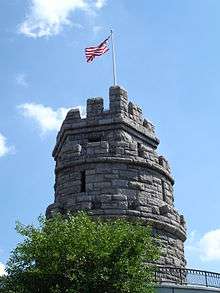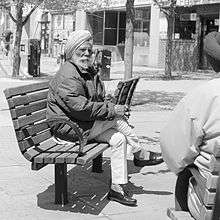Union Square (Somerville)
Union Square is a neighborhood in the southeastern part of Somerville, Massachusetts. It is centered on Union Square proper, which is located at the intersection of Washington Street, Webster Avenue, and Somerville Avenue.
The name "Union Square" comes from the square having been used as a recruitment and mustering site for the Union Army in the American Civil War. A plaque commemorating the mustering site sits at the southwest corner of the square between Somerville Avenue and Washington Street, and the Prospect Hill Monument is located several blocks away atop Prospect Hill. Union Square is now the commercial center of a primarily residential neighborhood with many restaurants, bars and neighborhood stores.
As the oldest and largest commercial area in the city, Union Square is home to a number of community institutions, including the Somerville Police headquarters, Somerville Community Access Television (SCATV), and Boston Free Radio.[1]
History
Sand Pit Square
Union Square was Somerville’s earliest commercial district to develop when it was still a part of Charlestown. Early trade routes passed through the Square and a tavern was built there as early as 1770. Originally called "Sand Pit Square," the area's sandy, clay pit-dotted pastures yielded a fine grade of silica used in glass and brick-making.[2]
American Revolution

It was during the American Revolution that Union Square took center stage. Because of its location and height providing panoramic views and control of Charlestown, Somerville, and Cambridge, Prospect Hill had great strategic importance in the Revolutionary War and became known as the "Citadel".[3]:1 The castle, dedicated in 1903, is a monument commemorating the fortifications atop the hill during that war.[3]:3 A tablet inside reads: "This tablet is erected in memory of the soldiers of the Revolution and of the Civil War who encamped on Prospect Hill and of the banners under which they valiantly fought."[4]
Somerville is one of several locales claiming to have hosted the first raising of the U.S. Flag, called the Grand Union Flag.[2] Tradition claims that George Washington raised the flag on Prospect Hill on January 1, 1776, and a plaque on the hill indicates such.[3]:2 However, some scholars dispute these traditional accounts, concluding that the flag raised at Prospect Hill was probably a British Union Flag.[5] Since a favorable surrender was then being offered to the rebelling colonists, the raising of a flag similar (or identical) to the Union Jack was briefly mistaken for a gesture of surrender.[6]
Industry growth
In its early years, Somerville was an agricultural suburb, supplying the growing urban area surrounding Boston. For a time the Union Square area was known as Milk Row after the small farms surrounding it.[1]
Union Square became a major commercial center during the early 19th century due to its location at an important crossroads. When the Warren Bridge opened to link Charlestown and Boston in 1828, it caused a considerable increase in traffic along Washington Street and Charlestown Lane (now Somerville Avenue). Railroad access began with the opening of the Fitchburg Railroad in 1843 and then opening of the Union Square railroad station just west of Webster Street. The Boynton Yards area south of the rail line and east of Union Square was created in 1874 when the swampy ground was filled with material from the top of Prospect Hill.[7] It became a meat packing and manufacturing district, with a slaughterhouse, brickyard, glass shop, and later other industries.[1]
After 1853, the square was known as Liberty Pole Square, in honor of the liberty pole erected there by anti-slavery firemen. In 1861 it was again renamed as Union Square as a pro-reunification gesture for the American Civil War and after the square's Revolutionary War history.[8]
In 1917, the first Marshmallow Fluff to be sold in stores was produced in Union Square. In honor of this, since 2006 an annual Somerville Fluff Festival has been held in Union Square.[9]
Service to the Union Square railroad station ended in 1938, as some local stops on the Fitchburg Railroad were dropped due to competition from streetcars.[10] By then, Union Square was well served, first by Boston Elevated Railway streetcars, then by buses.
Commerce and gentrification

Like much of Somerville, Union Square suffered economic decline in the 20th century as wealthy residents moved to more distant suburbs and manufacturing moved away from the area. The city began planning for a revitalization of Boynton Yards in the 1980s, including the construction of South Street to allow trucks to serve lots once only reachable by rail.[7] The area proceeded to attract new manufacturing, including Taza Chocolate, several breweries, and other food companies.[7][11]
With rents lower than nearby Cambridge, Union Square attracted new immigrant populations towards the end of the 20th century, including large groups of Brazilian, Punjabi, and Sikh residents.[12][13] Many markets in the area are run by and cater to the various ethnic groups that live in and around Union Square.
Union Square's location at the juncture of working-class East Somerville and the city's tonier western sections have made it the focal point of changing demographics. More upscale cafes, bars, and restaurants have opened since the 1990s, bringing gentrification deeper into Somerville. Union Square Main Streets, a local development group, began running a Saturday morning farmers' market in 2005 as one of its first visible efforts in the square.[14] A landscaped community garden with regularly scheduled concerts and artistic events sits just outside Union Square at the site of an old school.[15]
Transportation
Union Square is a minor hub for MBTA bus service, with 5 routes passing through:
- 85 Spring Hill–Kendall/M.I.T. station via Summer Street & Union Square
- 86 Sullivan station–Reservoir (Cleveland Circle) via Harvard/Johnston Gate
- 87 Arlington Center or Clarendon Hill–Lechmere station via Somerville Avenue
- 91 Sullivan Square station–Central Square via Washington Street
- CT2 Sullivan station–Ruggles station via Kendall/MIT
Green Line Extension
As part of the Green Line Extension project, Union Square station is being built just south of the square. In September 2013, the state secured funding and signed a 51-month $393 million contract that would allow Union Square station, along with the new East Somerville station and relocated Lechmere station, to open in 2017.[16] In 2014, Union Square station was expected to open in December 2017.[17] However, as of April, 2019, the station is not due to open until late 2021.[18]
References
- Somerville Strategic Planning and Community Development. "Union Square/Boynton Yards". City of Somerville. Archived from the original on May 2, 2010. Retrieved July 5, 2015.
- Gordon, Edward W. (September 2008). "Union Square Revisited: From Sand Pit to Melting Pot" (PDF). Somerville Historic Preservation Commission. Archived from the original (PDF) on December 13, 2013.
- Mulder, Steve. "The History of Prospect Hill: Where the first American flag ever flew". Mulder Media. Retrieved July 5, 2015.
- "Prospect Hill Park 2". CityVoter. Archived from the original on July 2, 2009. Retrieved July 5, 2015.
- Ansoff, Peter (2006). "The Flag on Prospect Hill" (PDF). Raven: A Journal of Vexillology. 13: 77–100. ISSN 1071-0043. Archived from the original (PDF) on July 5, 2015. Retrieved July 4, 2015.
- Crotty, Rob (September 14, 2010). "A funny thing happened on the way to the Revolutionary War". Prologue: Pieces of History. National Archives. Retrieved July 4, 2015.
- "Boynton Yards". Union Square Neighbors. Retrieved July 5, 2015.
- Doherty, Bob (April 3, 2013). "The Somerville News Historical Fact of the Week – April 3: Eagle Feathers #23 – Liberty Pole Square". The Somerville Times. Retrieved July 4, 2015.
- Annear, Steve (September 26, 2013). "What the Fluff?: The History of Your Favorite Sandwich Confection". Boston Magazine. Retrieved July 4, 2015.
- Central Transportation Planning Staff (January 2004). "Chapter 5C: Service Expansion" (PDF). 2004 Program for Mass Transportation. Boston Metropolitan Planning Organization. Archived from the original (PDF) on February 16, 2008. Retrieved December 5, 2012.
- Cain, Jacqueline (April 20, 2015). "Slumbrew Opens Brewery and Taproom in Boynton Yards". Boston Eater. Retrieved July 7, 2015.
- Twardzik, Cathleen (September 8, 2008). "Get a taste of Brazilian culture in Union Square". Somerville News. Retrieved July 7, 2015.
- Troutman, Ashley (September 5, 2010). "Somerville celebrates Punjabi, Sikh cultures in Union Square". Somerville News. Retrieved July 7, 2015.
- "Somerville's Union Square Debuts Weekly Farmers' Market on Saturday June 11" (Press release). City of Somerville. June 9, 2005. Archived from the original on June 13, 2005. Retrieved July 7, 2015.
- "Somerville Community Growing Center Homepage". The Growing Center. Retrieved July 3, 2015.
- Rosenberg, Steven A. (December 5, 2013). "Somerville poised to grow along Green Line". The Boston Globe. Retrieved December 7, 2013.
- "Washington Street and Union Square Stations: November 6, 2014" (PDF). Massachusetts Bay Transportation Authority. November 6, 2014. Retrieved July 5, 2015.
- Vaccaro, Adam (April 21, 2019). "Making tracks: Pace of work on Green Line extension project is picking up". The Boston Globe. Retrieved November 14, 2019.
External links
| Wikimedia Commons has media related to Union Square (Somerville, Massachusetts). |
| Wikimedia Commons has media related to Prospect Hill Park (Somerville, Massachusetts). |